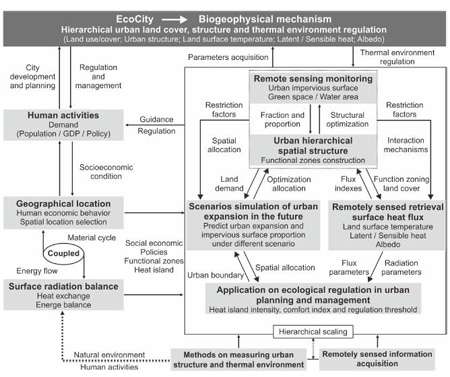Researchers develop new EcoCity model for mitigating urban heat islands

Urban land-use/cover changes and their effects on the eco-environment have long been an active research topic in the urbanization field. Prof. KUANG Wenhui's group at the Chinese Academy of Sciences has developed the EcoCity model for regulating urban land cover structures and thermal environments, and has established eco-regulation thresholds for urban surface thermal environments.
This research has shown that the difference in thermal environments among urban functional areas is closely related to the proportion of land-cover components. This work was published in Science China Earth Sciences.
The EcoCity model is based on the multidisciplinary integration of urban geography, urban climatology and urban ecology. The model is closely linked to "spatial location theory" in urban geography, "radiation and energy balance" in urban climatology, and provided the parameterization program for regulating land-cover components and thermal environment in urban planning and management application.
The EcoCity model can simulate the future urban expansion under different scenarios and predict the proportions of urban impervious surface areas and greenness, and the induced urban heat island effect. The core function of this model is spatially explicated information acquisition, including the proportion of impervious surface areas in different functional zones, the intensity of the urban heat island, and the indexes of human comfort.
The results provide fundamental data for regulating the impervious surface ratios in different functional zones and supporting urban heat island mitigation in future urban expansion.
Using Beijing as a study area, the researchers found significantly different surface temperatures in different functional zones, especially between urban impervious surfaces and green space. What's more, the temperatures in various surface covers were different.
"The difference in thermal environments among various urban functional zones is closely related to the composition of major land covers," said Prof. KUANG.
"The analysis of ecological thresholds of impervious surfaces and green space within various functional zones shows their different roles in thermal regulation effects. The urban-rural frontier and urban interior structure are characterized by high dynamics, structural complexity, and land-cover mosaics, resulting in challenges in obtaining accurate results for urban land cover components."
The EcoCity model and associated high-precision data and map products have been applied in different fields such as environmental protection, urban planning, and earthquake recovery.
More information: WenHui Kuang et al, An EcoCity model for regulating urban land cover structure and thermal environment: Taking Beijing as an example, Science China Earth Sciences (2017). DOI: 10.1007/s11430-016-9032-9
Journal information: Science China Earth Sciences
Provided by Chinese Academy of Sciences
















